Europe Telemedicine Market Size
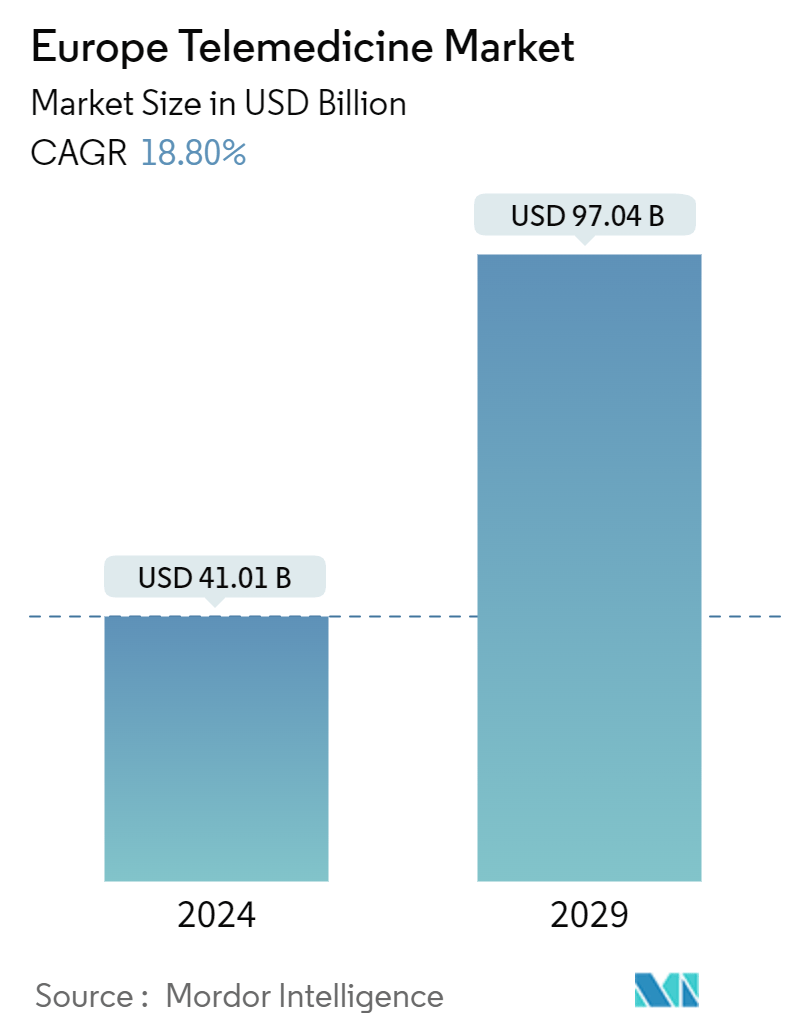
| Study Period | 2019 - 2029 |
| Market Size (2024) | USD 41.01 Billion |
| Market Size (2029) | USD 97.04 Billion |
| CAGR (2024 - 2029) | 18.80 % |
| Fastest Growing Market | Europe |
| Market Concentration | Medium |
Major Players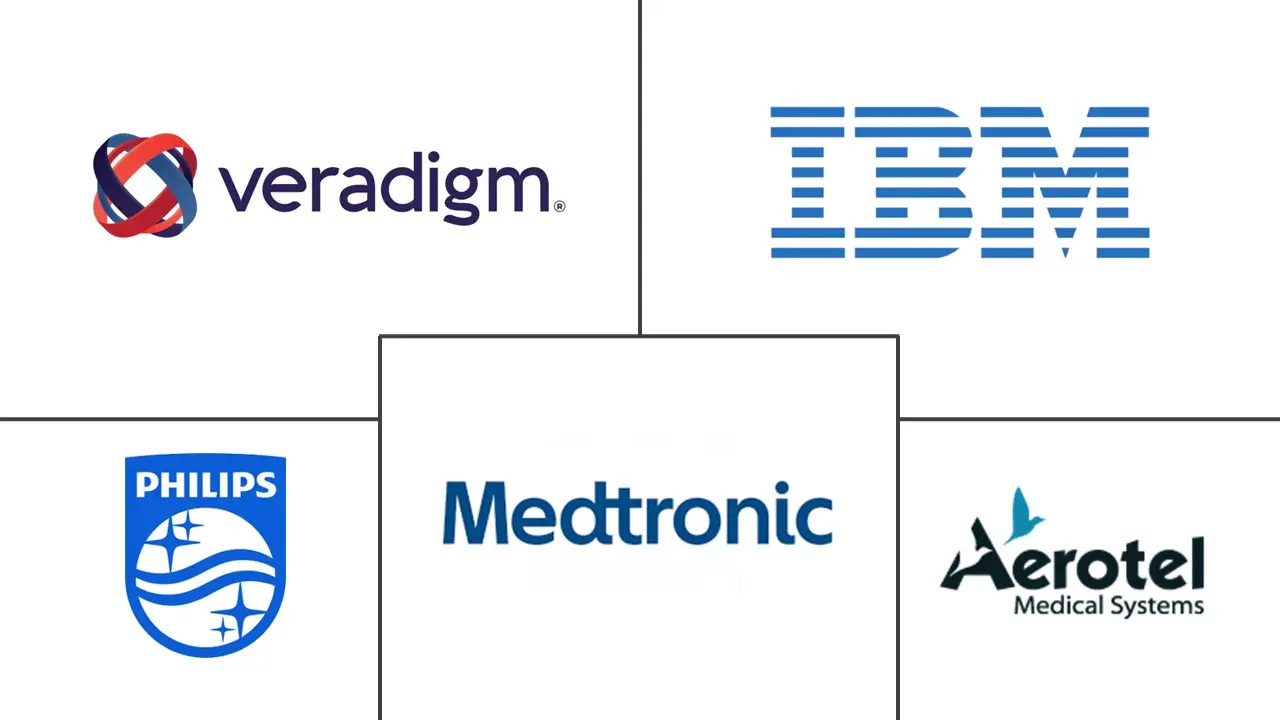
*Disclaimer: Major Players sorted in no particular order |
Europe Telemedicine Market Analysis
The Europe Telemedicine Market size is estimated at USD 41.01 billion in 2024, and is expected to reach USD 97.04 billion by 2029, at a CAGR of 18.80% during the forecast period (2024-2029).
The Europe Telemedicine Market is undergoing substantial growth, driven by critical factors transforming the healthcare sector across the continent. These forces are reshaping how healthcare is delivered and addressing pivotal challenges within European healthcare systems.
Megatrends and Macro Growth Drivers: Digital healthcare transformation, the need for cost-efficient solutions, and the shift towards patient-centered care models are driving the European Telemedicine Market. These trends are intertwined with other specific growth drivers, fueling the expansion of telemedicine in Europe.
Rising Healthcare Costs: Rising healthcare expenditures across Europe are propelling telemedicine adoption. As governments increase spending to enhance healthcare standards, there is a growing demand for cost-effective solutions. For example, countries like France, Denmark, Austria, the Netherlands, and Norway allocate 8-10% of their GDP to healthcare. Telemedicine helps mitigate costs linked to chronic disease management, reduce patient travel, and shorten hospital stays, offering a practical solution to escalating healthcare expenses.
Technological Innovations: The rapid digital transformation, accelerated by the COVID-19 pandemic, is significantly impacting healthcare delivery in Europe. The European Union and member states are spearheading initiatives to promote digital health. For instance, the EU4Health program allocates €5.1 billion to support healthcare's digital evolution. Meanwhile, investments in digital health startups are surging, with over 600 funded companies active across Europe. This innovation wave enhances telemedicine’s accessibility, efficiency, and integration within healthcare systems.
Increasing Remote Patient Monitoring: Remote patient monitoring (RPM) has emerged as a valuable tool in improving disease management. Products like MicroPort CRM's Bluetooth-enabled Alizea™ and Borea™ pacemakers exemplify the technological advancements fueling RPM growth. In the UK, Smith+Nephew and Huma launched an RPM service for orthopedic surgeries, optimizing preoperative care and outcomes. These innovations improve care quality while reducing strain on healthcare systems.
Growing Burden of Chronic Diseases: Chronic diseases represent a significant challenge for healthcare systems in Europe, with telemedicine offering solutions to mitigate this burden. One-third of the European population over 15 lives with a chronic condition. Telemedicine facilitates continuous monitoring and access to care, especially for diseases like diabetes, which affects 59 million adults in Europe. The technology enables early diagnosis and personalized care, making it invaluable for managing chronic conditions across the continent.
In summary, the Europe Telemedicine Market is driven by rising economic pressures, technological advances, changing healthcare demands, and the chronic disease burden. As these forces reshape the healthcare landscape, telemedicine will continue playing a crucial role in delivering high-quality, accessible healthcare.
Europe Telemedicine Market Trends
Software: Driving Innovation in Europe's Telemedicine Market
Segment Overview: Software solutions are at the core of the European telemedicine market, enabling remote consultations and diagnoses via digital platforms. This segment accounts for roughly 45% of the market, driven by its ability to streamline patient-provider communication and integrate into broader healthcare systems.
Growth Drivers: The software segment benefits from megatrends like the rise in chronic diseases and technological advancements in artificial intelligence (AI) and data analytics. The COVID-19 pandemic triggered a significant increase in teleconsultations across Europe. In France, weekly teleconsultations skyrocketed from 40,000 in early 2020 to nearly 1 million at the pandemic's peak. AI-powered tools and real-time analytics are transforming telemedicine software, offering personalized care and predictive diagnostics.
Competitive Landscape: As companies vie for market dominance, developing comprehensive software platforms that offer broad functionality is a priority. Collaborations and acquisitions, like HealthHero's acquisition of Fernarzt.com, are enabling companies to expand their service offerings. Leading players focus on optimizing user experience, ensuring data security, and integrating AI-driven features. This trend is driving the future growth of Europe’s telemedicine software market.
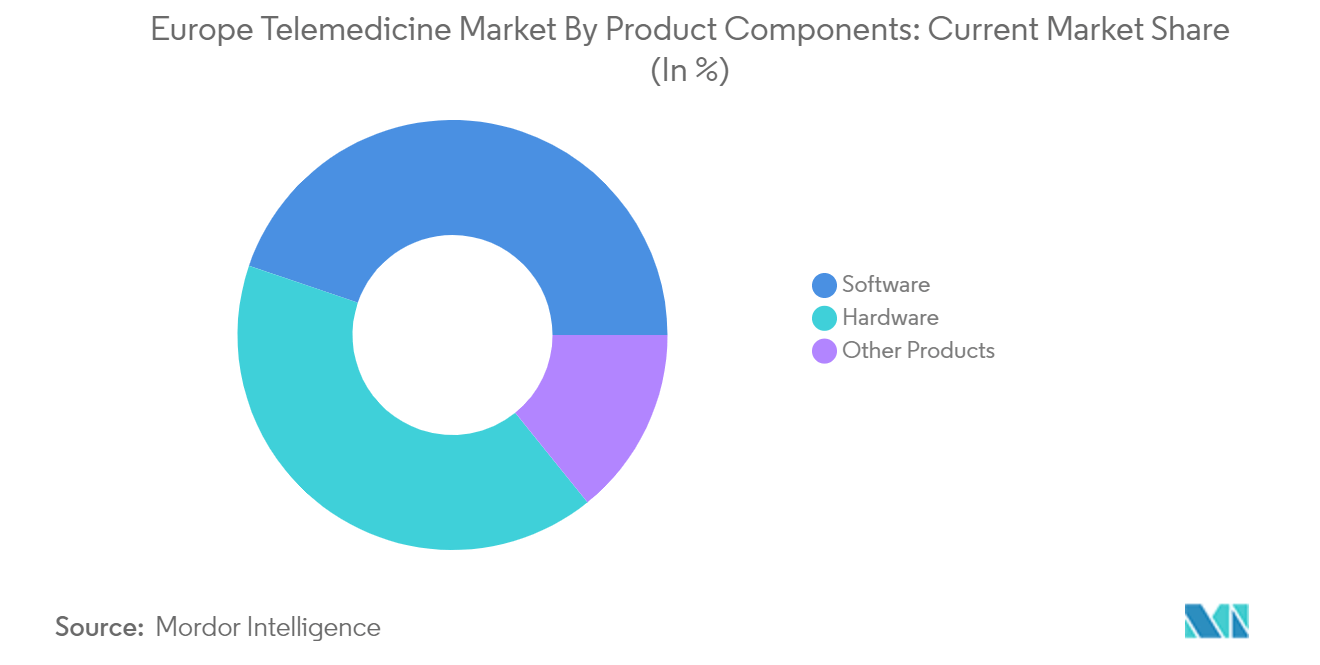
Germany: Spearheading Telemedicine Adoption in Europe
Regional Dynamics: Germany has emerged as a fast-growing telemedicine market within Europe, driven by robust healthcare infrastructure and progressive health policies. The market is expected to experience double-digit growth, outpacing other European countries due to Germany’s focus on healthcare digitization and addressing care gaps in rural regions.
Market Catalysts: Germany’s aging population and rising incidence of chronic diseases contribute to the growing demand for telemedicine services. The Digital Healthcare Act (DVG) of 2019 paved the way for integrating digital health into mainstream care. The COVID-19 crisis further accelerated telemedicine adoption, with German patients and healthcare providers rapidly embracing virtual care services.
Competitive Strategies: Companies eyeing the German telemedicine market are focusing on localization and compliance with stringent healthcare regulations. Collaborations with local healthcare providers are crucial for market entry, and investments in German-language platforms are key for user engagement. The market is expected to see increased competition between domestic startups and international players, fostering innovation and driving consolidation.
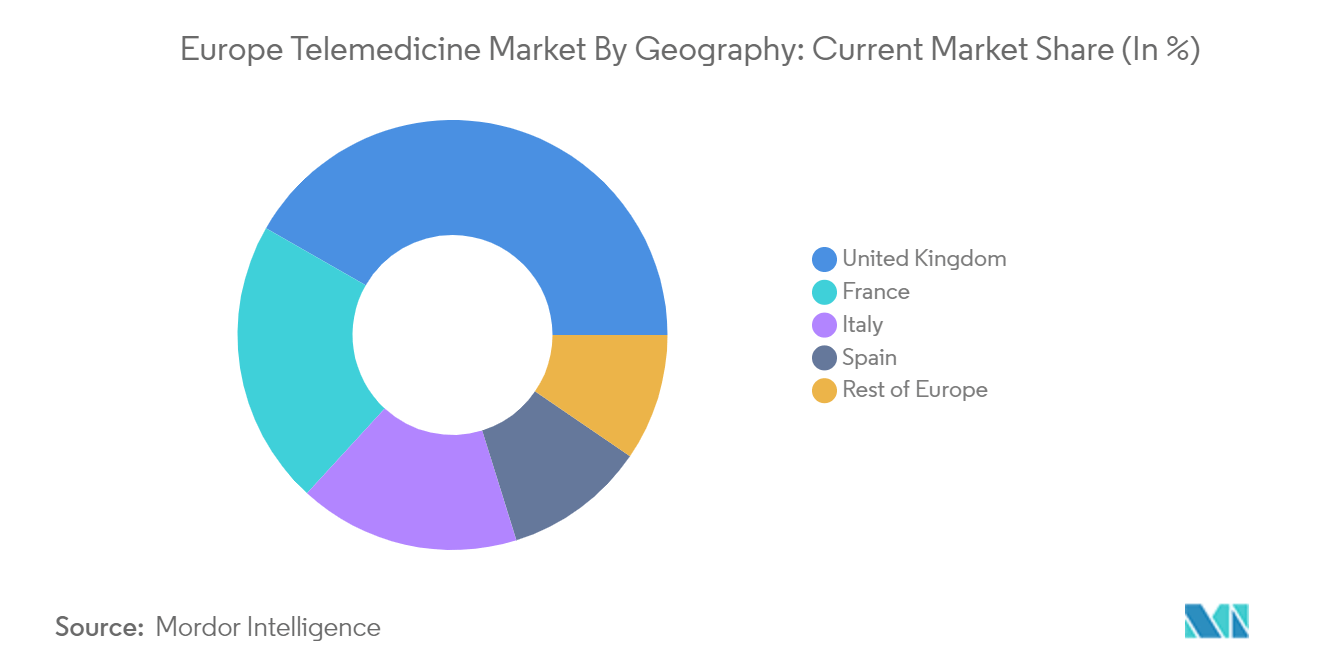
Europe Telemedicine Industry Overview
Market Dominance: Global Players and Specialized Companies Lead
The Europe Telemedicine Market is a mix of global healthcare conglomerates and specialized telemedicine providers. This moderately consolidated market sees major players like Koninklijke Philips NV, Medtronic PLC, and Teladoc Health Inc. dominate due to their strong technological expertise, broad healthcare portfolios, and significant resources.
Market Leaders: Technological Innovation and Comprehensive Solutions
Leading companies distinguish themselves through their commitment to innovation and comprehensive service offerings. Koninklijke Philips NV has developed integrated telehealth platforms, while Medtronic PLC offers remote monitoring for chronic diseases. Teladoc Health Inc., following its acquisition of InTouch Technologies, now offers an extensive suite of virtual care services. These leaders provide telemedicine solutions across multiple specialties, including telecardiology, teleradiology, and telepathology, catering to Europe’s diverse healthcare needs.
Strategies for Future Success: Integration and Regulatory Compliance
Looking ahead, telemedicine companies must integrate AI and machine learning technologies into their platforms to enhance diagnostics and deliver personalized care. Solutions that ensure seamless integration with existing healthcare infrastructure will likely secure a competitive edge. Adherence to Europe’s evolving regulatory frameworks, such as GDPR, is also critical for building trust and maintaining compliance. Firms that prioritize cybersecurity and demonstrate cost-effectiveness while improving patient outcomes are better positioned to capture market share and secure government support across Europe.
Europe Telemedicine Market Leaders
-
IBM Corporation
-
Koninklijke Philips NV
-
Medtronic Plc
-
Veradigm LLC
-
AMD Global Telemedicine
*Disclaimer: Major Players sorted in no particular order
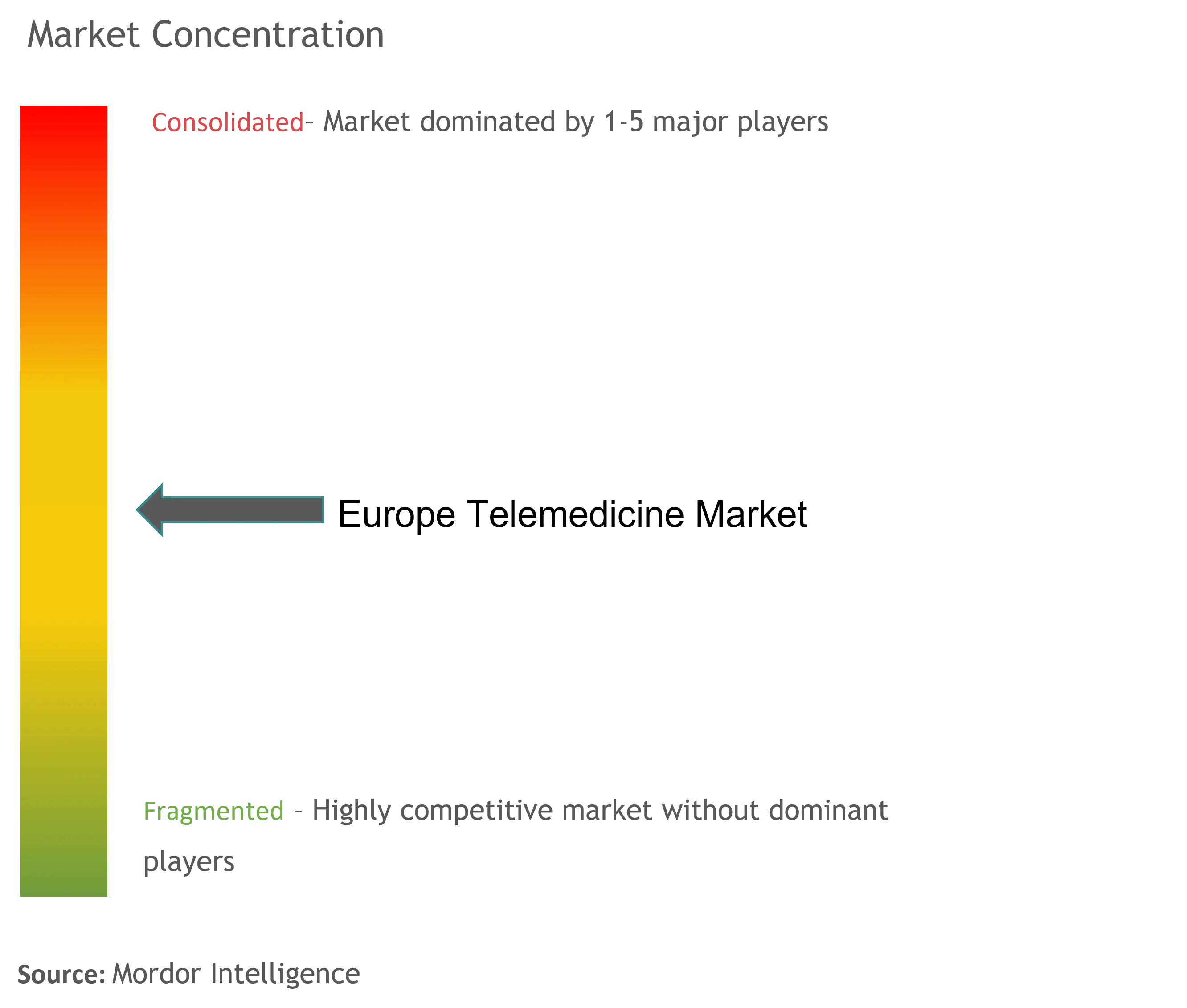
Europe Telemedicine Market News
- July 2024: WHO/Europe unveiled an evidence-based tool designed to bolster telemedicine services across nations. The Support Tool to Strengthen Telemedicine seeks to enhance telemedicine offerings, catering to needs ranging from individual health facilities to comprehensive national health systems.
- January 2024: Rudolf Riester GmbH signed a strategic collaboration agreement with Docs in Clouds TeleCare GmbH, one of the leading providers of software solutions for the healthcare sector. The collaboration aims to enhance Riester's telemedicine services with cutting-edge software. This partnership underscores Riester's commitment to delivering top-tier telemedicine solutions.
Europe Telemedicine Market Report - Table of Contents
1. INTRODUCTION
1.1 Study Assumptions and Market Definition
1.2 Scope of the Study
2. RESEARCH METHODOLOGY
3. EXECUTIVE SUMMARY
4. MARKET DYNAMICS
4.1 Market Overview
4.2 Market Drivers
4.2.1 Increasing Remote Patient Monitoring
4.2.2 Growing Burden of Chronic Diseases
4.3 Market Restraints
4.3.1 Legal and Reimbursement Issues
4.4 Porter's Five Forces Analysis
4.4.1 Bargaining Power of Suppliers
4.4.2 Bargaining Power of Buyers/Consumers
4.4.3 Bargaining Power of Suppliers
4.4.4 Threat of Substitute Products
4.4.5 Intensity of Competitive Rivalry
5. MARKET SEGMENTATION (Market Size by Value -USD)
5.1 By Type
5.1.1 Telehospitals
5.1.2 Telehomes
5.1.3 mHealth (Mobile Health)
5.2 By Component
5.2.1 By Products
5.2.1.1 Hardware
5.2.1.2 Software
5.2.1.3 Other Products
5.2.2 By Services
5.2.2.1 Telepathology
5.2.2.2 Telecardiology
5.2.2.3 Teleradiology
5.2.2.4 Teledermatology
5.2.2.5 Telepsychiatry
5.2.2.6 Other Services
5.3 By Mode of Delivery
5.3.1 On-premise Delivery
5.3.2 Cloud-based Delivery
5.4 Geography
5.4.1 Germany
5.4.2 United Kingdom
5.4.3 France
5.4.4 Italy
5.4.5 Spain
5.4.6 Rest of Europe
6. COMPETITIVE LANDSCAPE
6.1 Company Profiles
6.1.1 Aerotel Medical Systems (1998) Ltd
6.1.2 Veradigm LLC
6.1.3 AMD Global Telemedicine
6.1.4 OTH.IO
6.1.5 International Business Machinery Corporation (IBM)
6.1.6 Teladoc Health Inc.
6.1.7 Resideo Technologies Inc.
6.1.8 Koninklijke Philips NV
6.1.9 Medtronic PLC
6.1.10 SHL Telemedicine
- *List Not Exhaustive
7. MARKET OPPORTUNITIES AND FUTURE TRENDS
Europe Telemedicine Industry Segmentation
As per the scope of the report, telemedicine refers to the remote diagnosis and treatment of patients with the help of telecommunications technology. Various kinds of telemedicine services, along with devices, have been tracked in the report.
The European telemedicine market is segmented by type, component, services, mode of delivery, and country. By type, the market is segmented into tele hospitals, tele homes, and mHealth. By component, the market is segmented into products and services. By delivery, the market is segmented into on-premise delivery and cloud-based delivery. By geography, the market is segmented into Germany, the United Kingdom, France, Italy, Spain, and the Rest of Europe. The report offers the value (USD) for the above segments.
| By Type | |
| Telehospitals | |
| Telehomes | |
| mHealth (Mobile Health) |
| By Component | ||||||||
| ||||||||
|
| By Mode of Delivery | |
| On-premise Delivery | |
| Cloud-based Delivery |
| Geography | |
| Germany | |
| United Kingdom | |
| France | |
| Italy | |
| Spain | |
| Rest of Europe |
Europe Telemedicine Market Research FAQs
How big is the Europe Telemedicine Market?
The Europe Telemedicine Market size is expected to reach USD 41.01 billion in 2024 and grow at a CAGR of 18.80% to reach USD 97.04 billion by 2029.
What is the current Europe Telemedicine Market size?
In 2024, the Europe Telemedicine Market size is expected to reach USD 41.01 billion.
Who are the key players in Europe Telemedicine Market?
IBM Corporation, Koninklijke Philips NV, Medtronic Plc, Veradigm LLC and AMD Global Telemedicine are the major companies operating in the Europe Telemedicine Market.
Which is the fastest growing region in Europe Telemedicine Market?
Europe is estimated to grow at the highest CAGR over the forecast period (2024-2029).
What years does this Europe Telemedicine Market cover, and what was the market size in 2023?
In 2023, the Europe Telemedicine Market size was estimated at USD 33.30 billion. The report covers the Europe Telemedicine Market historical market size for years: 2019, 2020, 2021, 2022 and 2023. The report also forecasts the Europe Telemedicine Market size for years: 2024, 2025, 2026, 2027, 2028 and 2029.
Europe Telemedicine Industry Report
Statistics for the 2024 Europe Telemedicine market share, size and revenue growth rate, created by Mordor Intelligence™ Industry Reports. Europe Telemedicine analysis includes a market forecast outlook to 2029 and historical overview. Get a sample of this industry analysis as a free report PDF download.



